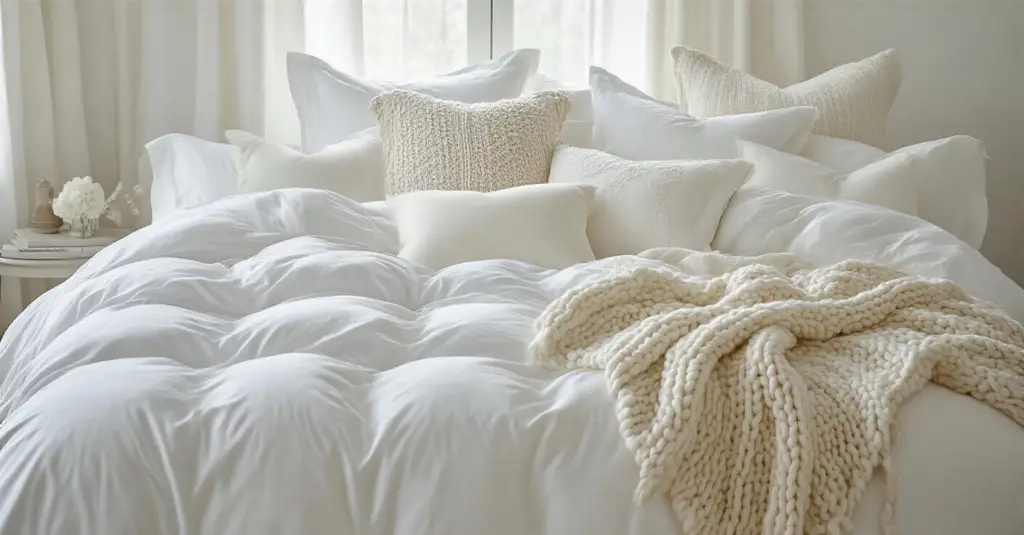Picture this: You’re standing in your bedroom. You’ve painted the walls a brilliant, cloud-like white. You bought the crisp white duvet. You followed all the inspiration photos to the letter. You have the perfect canvas for your serene, clutter-free sanctuary. But as you stand there, something feels… off. Instead of feeling like a gentle hug, the room feels like a sterile laboratory. It’s clean, sure, but it’s cold. It’s bright, but it has no soul.
This is the hidden limitation of a white bedroom that nobody talks about. You think you’ve created a sophisticated retreat, but you’ve actually created a blank box. The secret isn’t finding the perfect shade of white paint or buying more white things; it’s understanding the counter-intuitive truth that a beautiful white room is never just about the color white. It’s about texture, warmth, and the artful dance of light.
This is the real story, the one you need to turn that clinical space into the personal sanctuary you’ve been dreaming of.
Setting the Bright Stage: Foundational Planning for Your White Bedroom (Part 1)
Before you even think about bedding or art, we need to lay the groundwork. This is the unglamorous part that makes all the difference, the foundation that prevents your dream room from turning into a design nightmare. Think of it as preparing the canvas properly so the final painting can truly shine. It’s all about understanding your space and how it behaves.
1. Assess Your Room’s Natural Light for Optimal White Tones
People always ask me for the “best” white paint, and my answer is always the same: I have no idea. Not until I see how the light works in your room. Natural light is a bully; it will push your paint around all day, changing its color from hour to hour. A beautiful, creamy white in the store can look sickly yellow in a west-facing room in the afternoon, and a crisp, modern white can turn into a sad, icy blue in a north-facing room. This isn’t about preference; it’s physics.
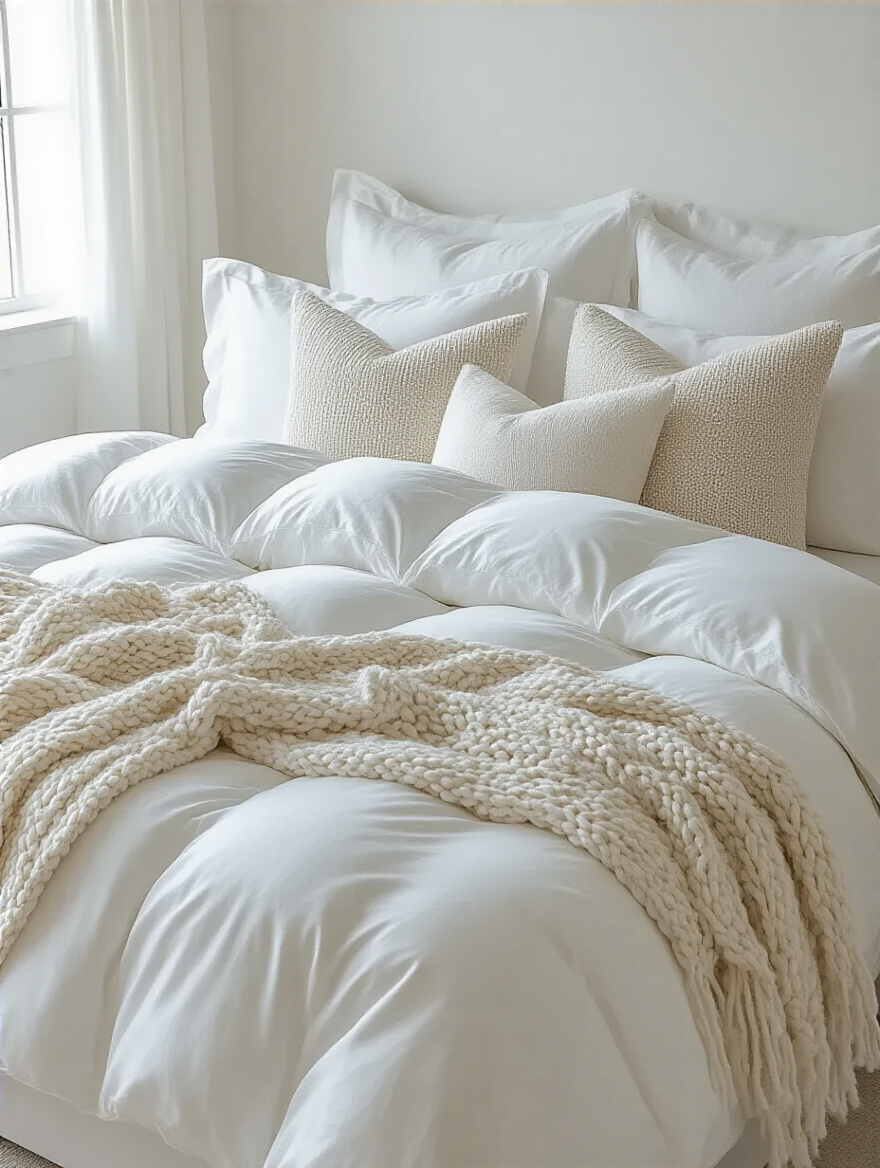
So, the most important shortcut is this: stop trusting those tiny paint chips. They are lying to you. Go to the store and get sample pots of three or four different whites you think you like. Paint a huge swatch—at least two feet by two feet—of each one on your main walls. Then, live with them for two days. Watch them in the morning light, at high noon, and as the sun sets. The one that holds its character the best and makes you feel the way you want to feel is your winner. This step alone will save you more money and heartache than any other.
And once you’ve done the heavy lifting of choosing your main color, the rest of the plan can start to fall into place, guided by the mood you’ve now set.
2. Define Your White Palette: Understanding Undertones and Their Impact
Okay, let’s get a little technical, but I promise it’s worth it. “White” is a myth. Every single white paint has a tiny drop of another color in it—an undertone. It could be yellow, pink, blue, or grey, and that undertone is what will determine the entire mood of your room. A white with a yellow undertone will feel warm, sunny, and classic, like a bowl of vanilla ice cream. A white with a blue or grey undertone will feel crisp, modern, and cool, like a fresh snowfall. There’s no right or wrong, but getting it wrong for your space is a disaster.
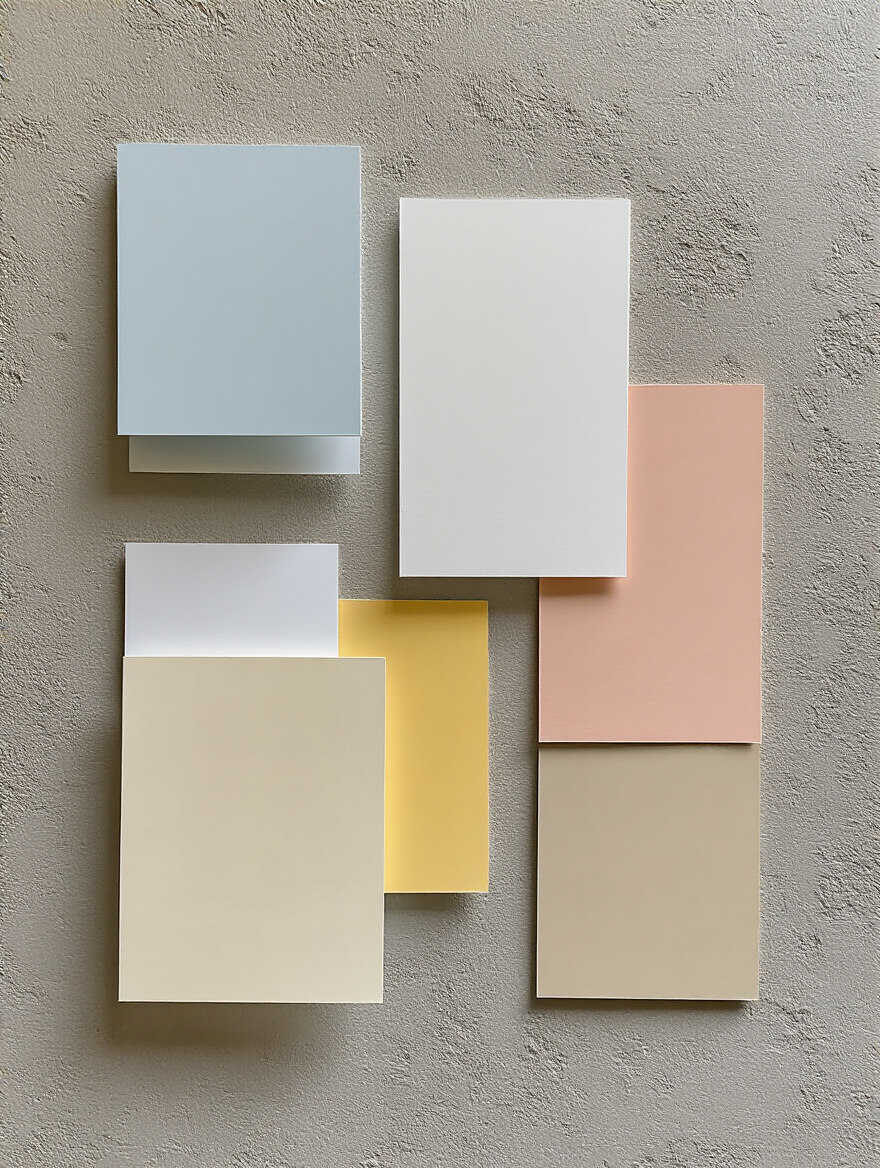
I once had a client who paired a very cool, blue-white paint with warm, honey-colored oak floors. It was a complete clash. The walls looked jarringly blue and the floors looked almost orange. The fix? We repainted with a soft, warm white that had a creamy, almost beige undertone. Suddenly, the entire room felt cohesive and wrapped you in a warm hug. Always hold your paint swatches up against your floors, your trim, and any big furniture you can’t change. Let them tell you which undertone will play nicely.
This thoughtful selection process is the bedrock of your design, a decision that will quietly support every other element you bring into the space.
3. Prioritize Practicality: How Functionality Guides White Furniture Choices
Can we talk about the fantasy of pristine white furniture versus the reality? The fantasy is a catalog-perfect room that’s always clean. The reality is kids with sticky fingers, a dog that loves to jump on the dresser, and life happening all over the place. Choosing white furniture isn’t about giving up; it’s about choosing smarter. The real noise here is thinking you have to sacrifice style for durability. You don’t. The secret is in the finish.
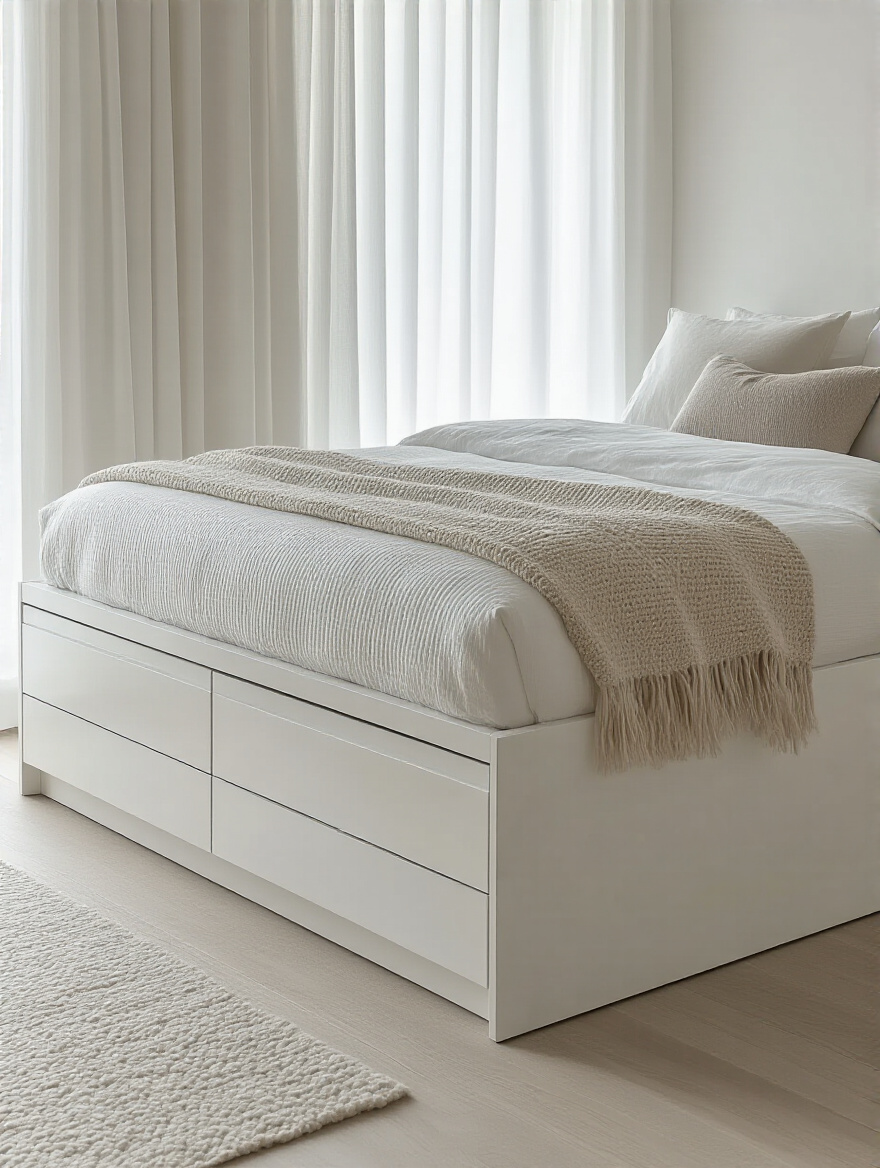
Look for pieces with a high-quality lacquer, a baked-on enamel, or a durable laminate finish. These are way easier to wipe down and are much more resistant to stains and chips than a piece with just a simple coat of matte paint. If you’re going for an upholstered piece like a headboard or a chair, please, for the love of all that is cozy, look for performance fabrics. Brands like Crypton or Sunbrella make fabrics that look and feel incredible but are engineered to repel spills. You can literally spill red wine on some of them, blot it, and it’s gone. That’s not a fantasy; it’s just smart textile selection.
Investing in these functional pieces from the start allows you to build a room that is not just beautiful, but truly livable, freeing you up to focus on the layers that bring it to life.
4. Curate Complementary Textures: The Secret to Depth in a Monochromatic Scheme
If you remember only one thing from our chat, let it be this: Texture is more important than the exact shade of white. A white room without texture is boring. A white room with layers of different textures is a masterpiece. This is the number one shortcut to making a white room feel warm, inviting, and incredibly sophisticated. Texture is what our eyes feel, and it’s what stops white from feeling flat.
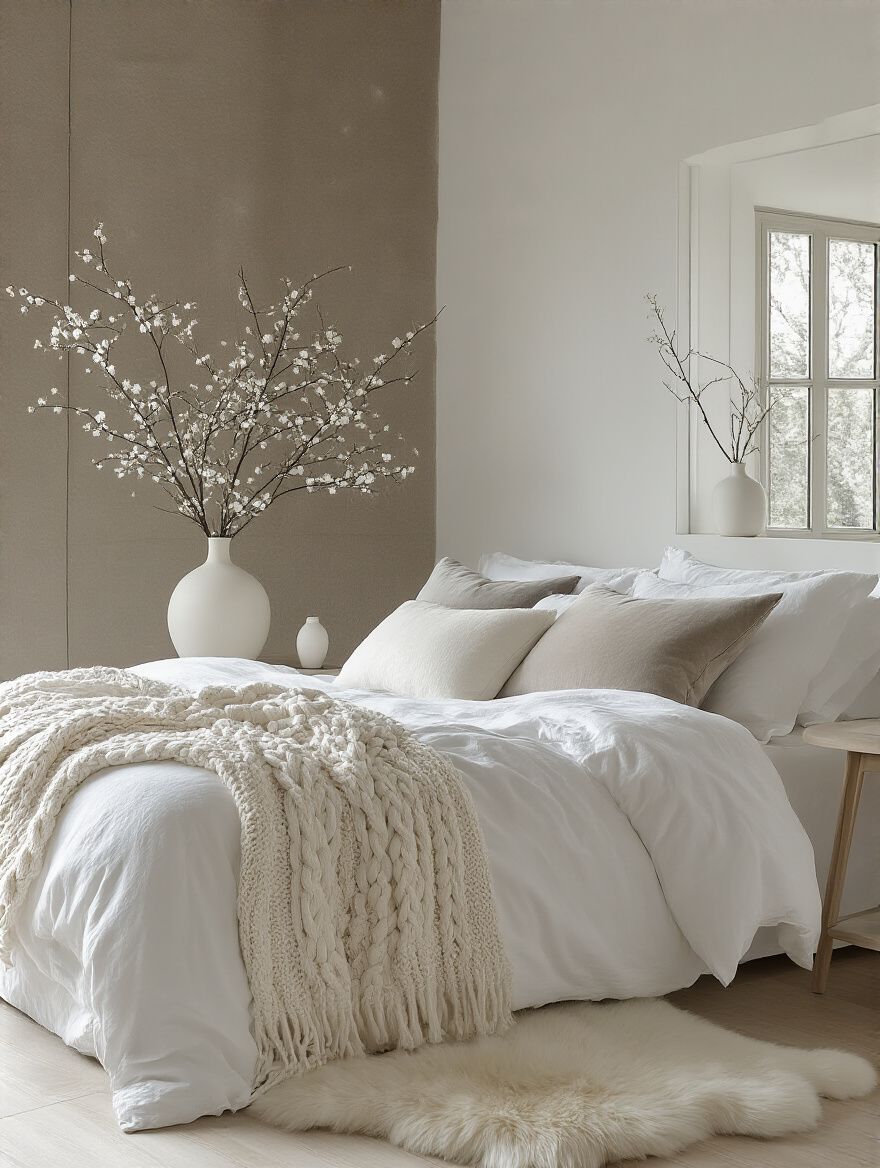
So, go on a texture hunt. Think about every surface. Your bed isn’t just a white duvet; it’s a crisp linen duvet cover, topped with a chunky cable-knit wool throw, piled with a couple of slubby cotton pillows and maybe one velvet cushion for a touch of sheen. Your floor isn’t bare; it’s covered with a plush, high-pile wool rug or a woven jute rug for a more organic feel. Your windows have soft, sheer linen curtains that diffuse the light beautifully. You want to mix smooth with rough, shiny with matte, and soft with structured. This is how you create a room that begs you to come in and touch everything.
Setting the Bright Stage: Foundational Planning for Your White Bedroom (Part 2)
With the fundamental choices of color and texture sorted, there’s one final, crucial piece of planning. This step isn’t about buying anything; it’s about deciding what you want your room to feel like. It’s the compass that will guide every single one of your future styling decisions.
5. Establish Your Overall Mood: From Serene Sanctuary to Modern Minimalist
Before you buy another thing, ask yourself this question: “When I walk into this room, what feeling do I want to wash over me?” Be specific. Is it “serene spa”? “Cozy cabin”? “Crisp hotel”? “Bohemian retreat”? Write it down. This is your design mantra. It will save you from making impulse buys that don’t fit the vision. For example, a distressed, shabby-chic mirror has no place in a “modern minimalist” room, and a sleek chrome lamp will look out of place in a “cozy cabin.”
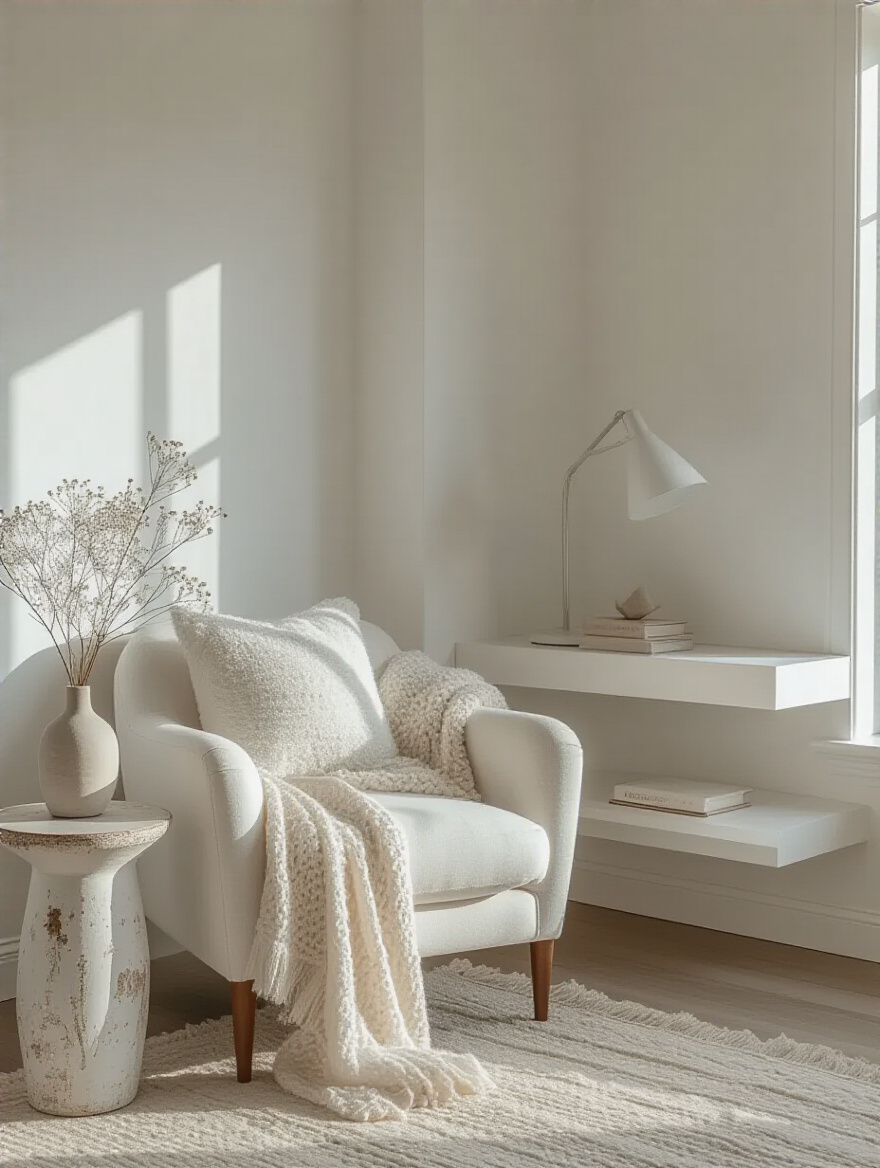
Having a clear mood in mind is the shortcut to effortless decision-making. A “serene spa” mood tells you to look for linen, soft lighting, and natural woods. A “crisp hotel” mood points you toward high-thread-count percale sheets, tailored lines, and maybe a metallic accent. I once had a client who was completely overwhelmed. We simply defined her mood as “warm, coastal calm.” Suddenly, everything clicked. She knew to look for whitewashed wood, woven baskets, and art depicting soft seascapes. Your mood is your filter; run every potential purchase through it.
Building Your Luminous Haven: Core Elements and Thoughtful Selections (Part 1)
Now that we have our foundation and our guiding mood, we can start building. This is where we select the big players—the pieces that will form the backbone of your luminous haven. We’ll choose them thoughtfully to ensure they not only fit the aesthetic but also work hard to make the room feel spacious, warm, and inviting.
6. Choose White Foundation Furniture for Timeless Versatility
I know it can be tempting to get a statement bed or a bold-colored dresser, but for a truly versatile white bedroom, stick with white for your core furniture pieces—the bed frame, the dresser, the nightstands. Here’s why: it makes the room feel so much bigger. Large pieces of dark furniture can feel like they’re sucking all the light and space out of a room. White furniture, on the other hand, seems to blend into the walls, creating a seamless, airy effect that is incredibly calming.
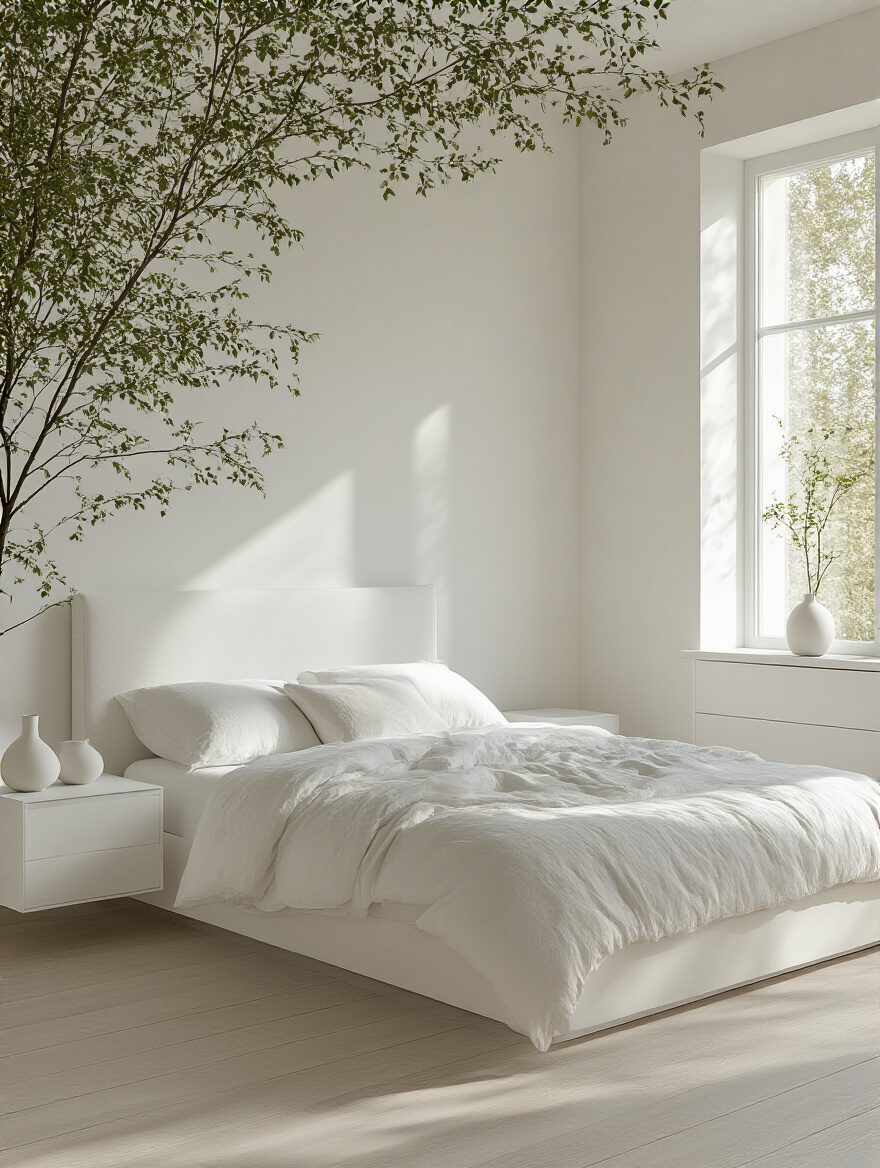
This is also a long-term investment in your sanity. With a canvas of white furniture, you can change the entire look of your room just by swapping out pillows, throws, and art. If you decide you’re over sage green and want to move on to dusty rose, it’s a simple, inexpensive change. If you had a sage green bed frame? Not so easy. Just be sure to apply that practicality rule we talked about—look for durable finishes that will stand the test of time and resist yellowing.
With our core furniture selected, we can now move to the most important element for comfort: the textiles that will adorn them.
7. Layer Soft Bedding and Textiles for Cloud-Like Comfort
Your bed is the heart of the bedroom, and it should look and feel like a cloud. The biggest mistake people make is buying a “bed-in-a-bag.” It’s a one-note disaster that lacks any depth. Instead, build your bed layer by delicious layer. Start with high-quality sheets—I love the cool, crisp feeling of percale or the soft, lived-in texture of linen. Then, add a duvet. A pro tip: buy a duvet insert that is one size larger than your duvet cover. A king insert in a queen cover will make it look extra full and luxurious, just like in the catalogs.
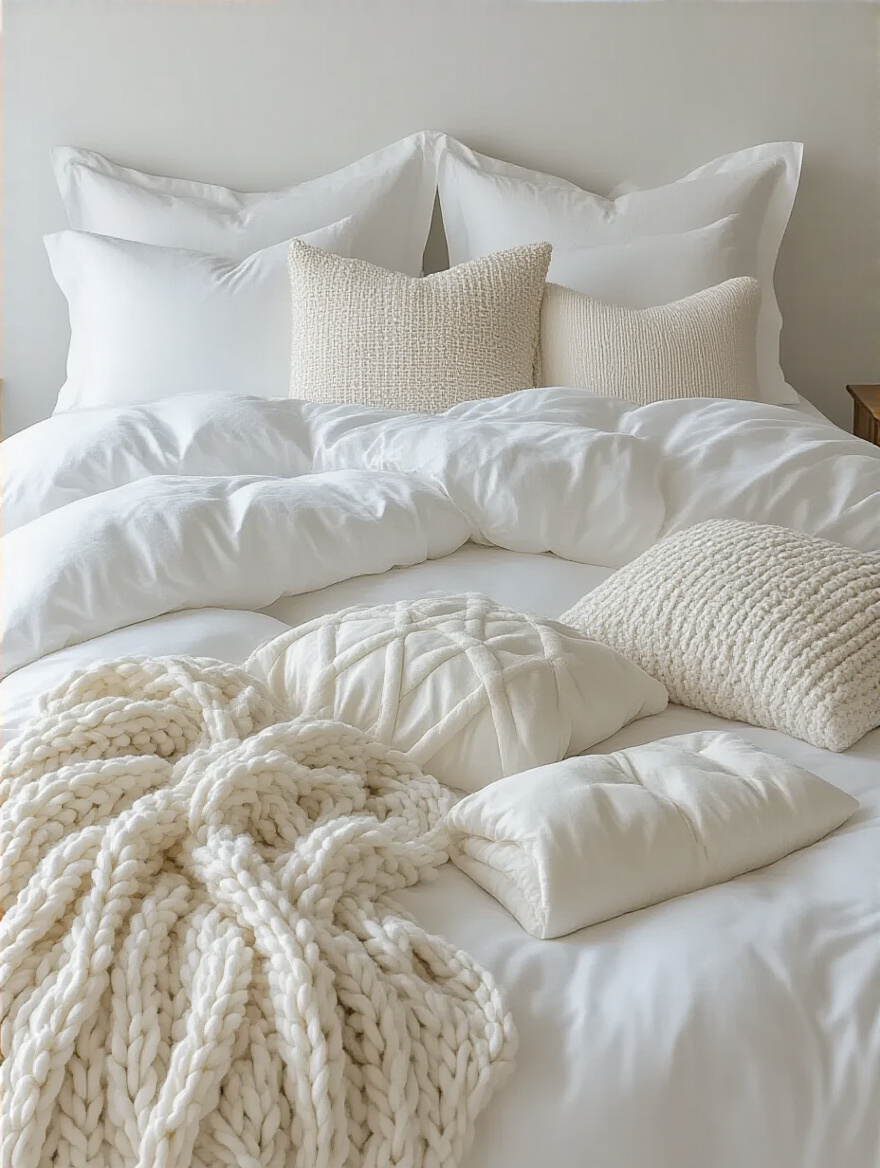
Now, for the magic. Add a quilt or a coverlet folded at the foot of the bed. This could be a lightweight waffle weave in the summer or a plush velvet quilt in the winter. Finally, the pillows and a throw blanket. A mix of different-sized pillows—large squares (Euros), your sleeping pillows, and a smaller decorative cushion or lumbar pillow—creates that effortless, “sink-in” look. And a soft throw, draped casually over a corner, is the final invitation. Don’t be afraid to mix different shades of white and cream here; that subtle variation is what makes it look so rich.
The goal is to create a space so soft and inviting that other, harder surfaces feel naturally balanced, which brings us to the smart use of reflection.
8. Incorporate Reflective Surfaces to Amplify Brightness
In a white room, light is your best friend, and reflective surfaces are like a cheering squad for the light. Mirrors are the most obvious choice, and a large mirror placed opposite a window is an old designer trick for a reason—it can literally make a room feel twice as big and twice as bright. But you don’t have to stop at mirrors.
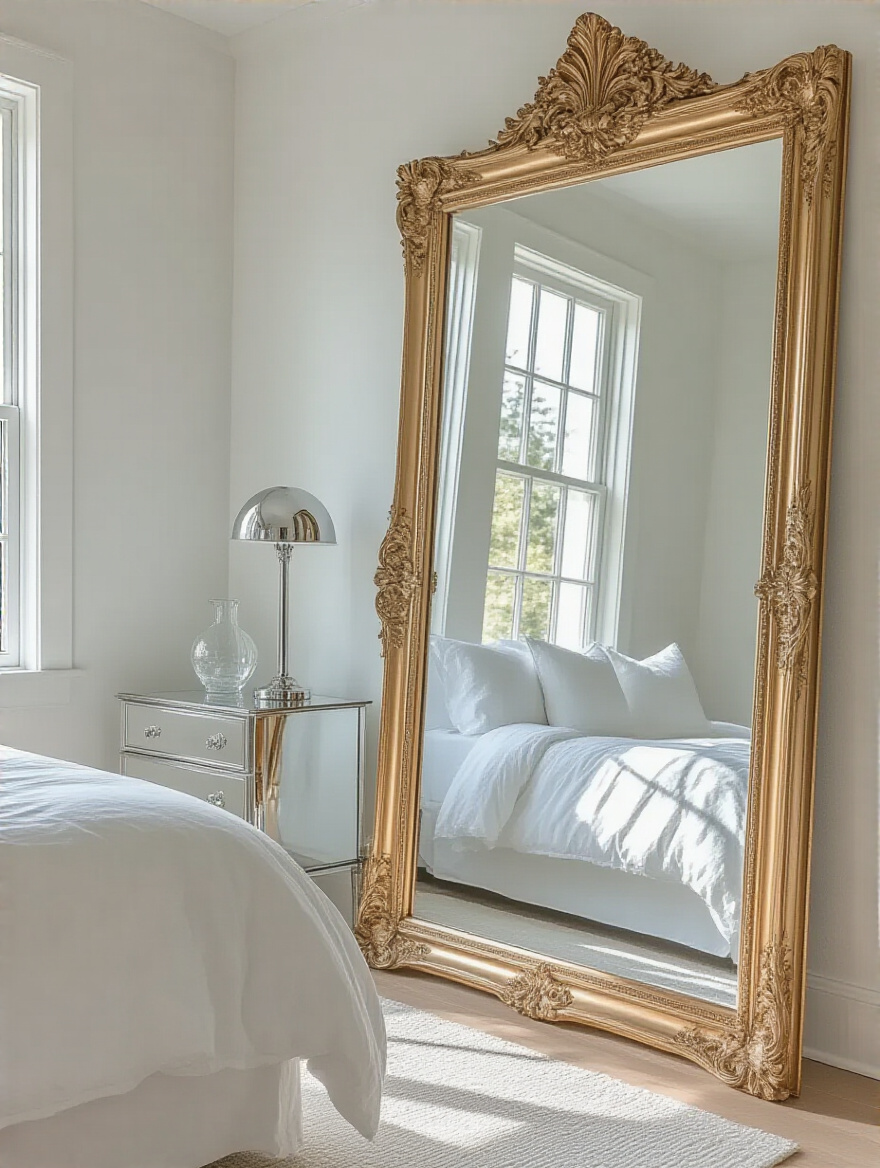
Think about other reflective touches. A bedside lamp with a polished chrome or brass base will catch the light beautifully. A dresser with mirrored drawer fronts can add a touch of glamour. Even small things, like glass or acrylic hardware on your cabinets or silver picture frames, bounce light around the room in subtle, beautiful ways. These little flashes of sparkle prevent the room from feeling too matte or flat, adding a layer of sophistication without adding another color.
But to truly balance all this brightness and softness, we need an element that feels solid and grounding.
9. Introduce Strategic Warm Woods to Prevent Clinical Feels
An all-white room, even with beautiful textures, can sometimes feel a bit unmoored, like it’s floating. The fastest way to ground it and inject some soulful warmth is with wood. A touch of a natural wood tone—whether it’s a light oak, a rich walnut, or a rustic reclaimed pine—is the perfect antidote to the “clinical” feeling. It adds an organic element that is instantly calming and connects the space back to nature.
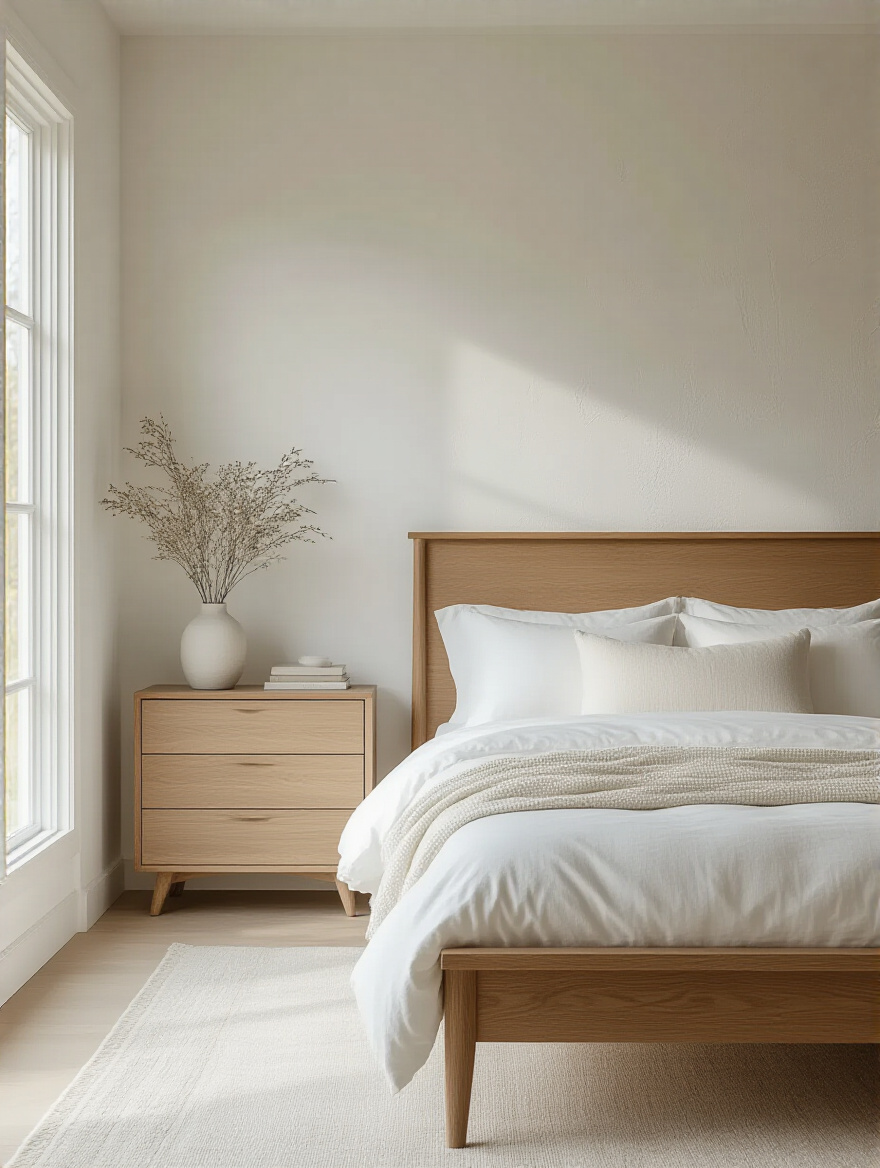
This doesn’t mean you need a full set of wood furniture. The effect can be achieved with just a few strategic pieces. Maybe it’s a simple wooden bench at the foot of the bed. Perhaps it’s a pair of nightstands in a warm oak, or just some wooden picture frames on the wall. I once worked on a very modern white bedroom that felt cold, and we simply swapped the metal curtain rod for a simple, light wood one. It was a tiny change, but it instantly warmed up the entire window wall and made the room feel complete.
Building Your Luminous Haven: Core Elements and Thoughtful Selections (Part 2)
We’ve got the big pieces in place. Now it’s time to focus on the elements that control the atmosphere of the room. This is where we fine-tune the space, controlling the light, managing privacy, and ensuring the serene aesthetic isn’t spoiled by everyday clutter. These are the details that make a room not just look good, but work beautifully.
10. Optimize Lighting Fixtures for Ambiance and Function
The single overhead light fixture—the dreaded “boob light”—is the enemy of good bedroom ambiance. Lighting needs to come from multiple sources and at different heights to create a warm, inviting glow. In a white room, which reflects light so efficiently, this is doubly important to avoid harsh glare. You need at least three points of light: ambient (a beautiful flush mount or chandelier), task (bedside lamps for reading), and maybe an accent (a floor lamp in a corner).
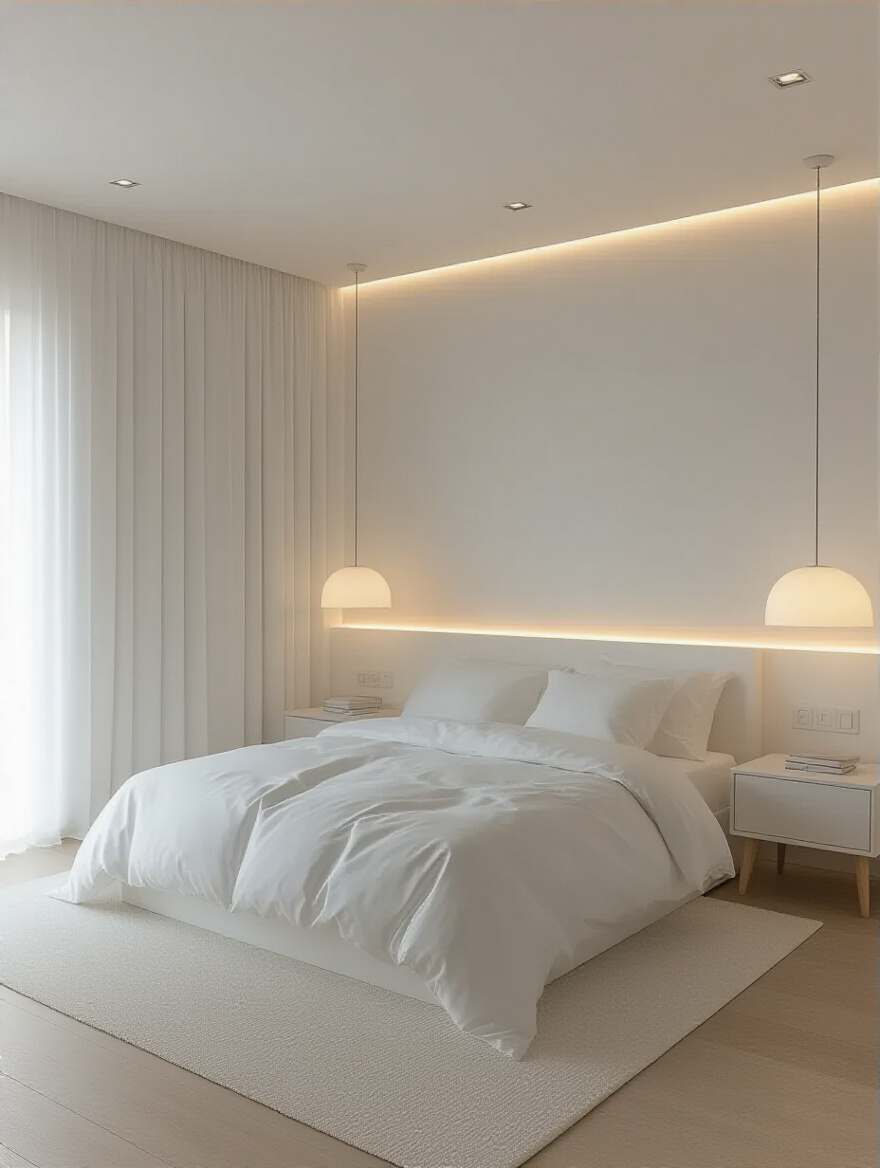
And here’s the shortcut that designers swear by: put everything on a dimmer. Everything. This is a non-negotiable. Being able to dim the lights is the single most effective way to change the mood of a room from bright and functional for cleaning, to soft and romantic for winding down. Also, pay attention to the bulb’s temperature. Look for bulbs marked “warm white” (around 2700K). This will cast a soft, yellowish glow that is much more flattering and relaxing than the harsh, blue-ish light of “cool white” bulbs.
Proper lighting ensures your room feels cozy day and night, but during the day, your windows play the leading role in atmosphere control.
11. Select Window Treatments to Control Light and Add Softness
Bare windows can look stark and unfinished, especially in a bedroom where softness and privacy are key. Your window treatments are an opportunity to add another gorgeous layer of texture while also giving you complete control over the light. The most luxurious and versatile option is a layered approach: a functional shade for light control paired with soft decorative curtains.
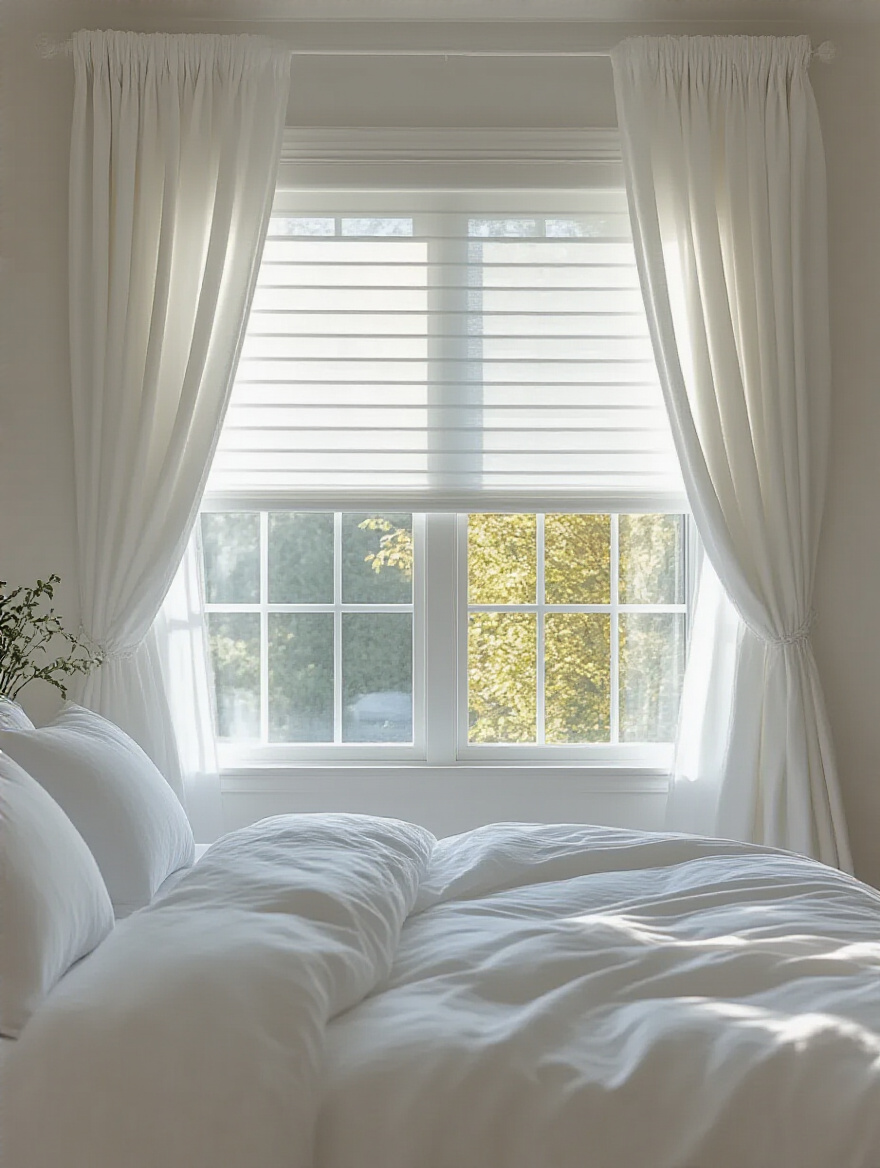
For the functional layer, a blackout roller shade or a cellular shade will allow you to plunge the room into darkness for sleeping—a crucial element for good rest. Then, flank the window with stationary curtain panels. They don’t even have to be functional; their job is purely aesthetic. Sheer linen is my absolute favorite. It doesn’t block the light but softens and diffuses it, making the entire room glow. A pro tip: hang your curtain rod high and wide—at least 6-12 inches above and beyond the window frame. This makes your windows look larger and more grand.
With light and privacy handled, the final functional challenge is keeping the beautiful, minimal space looking that way.
12. Integrate Discreet Storage Solutions for a Clutter-Free Aesthetic
Visual clutter is the nemesis of a serene white bedroom. In a white space, every out-of-place item screams for attention. The secret isn’t to own less stuff (though that helps!), but to have smart, discreet storage for the stuff you have. The best storage is the kind you don’t even see. Think about furniture that does double duty. A bed with built-in drawers underneath is a game-changer. An elegant ottoman or bench at the foot of the bed can hide a multitude of sins, like extra blankets or shoes.
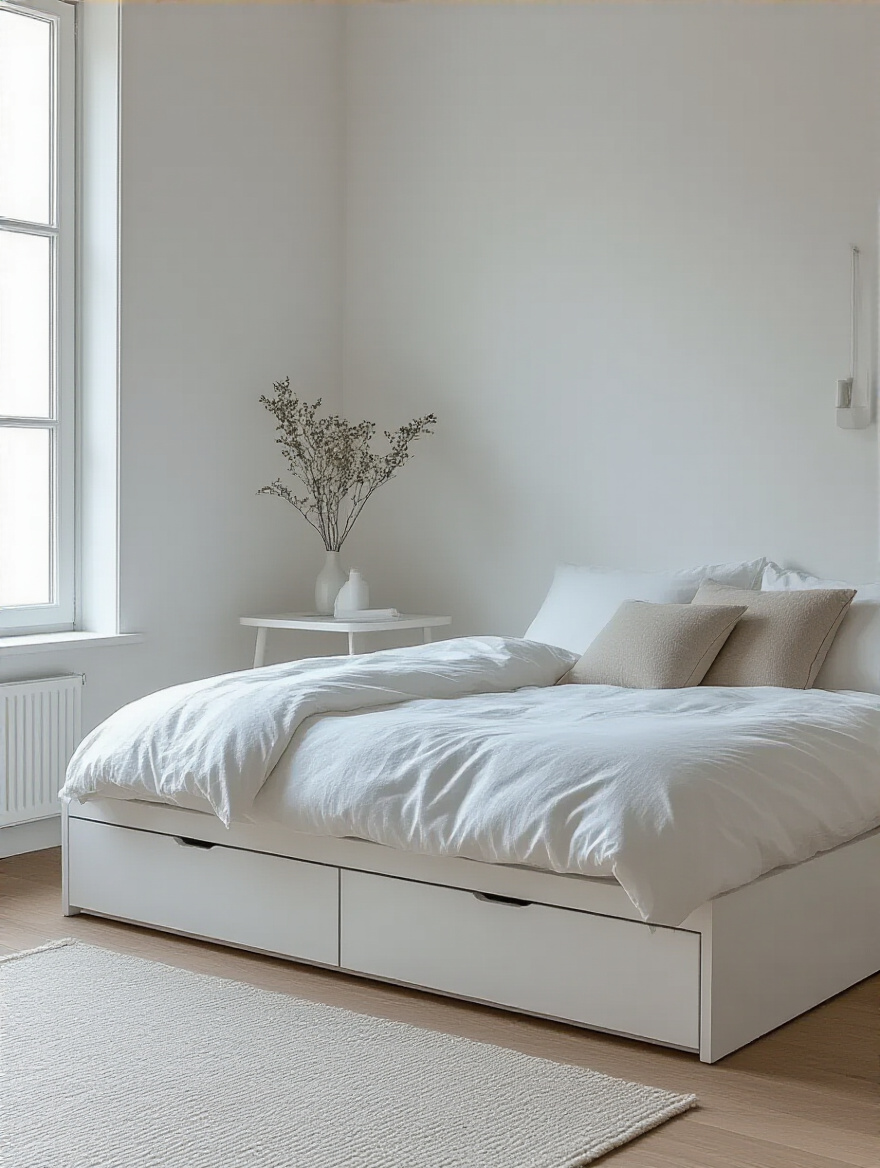
If you have the option, built-in wardrobes painted the same white as the walls are the ultimate solution. By eliminating the visual break of a freestanding piece of furniture, they make the room feel seamless and expansive. For smaller items, use beautiful boxes and baskets that are a pleasure to look at. A woven basket for laundry or a stack of elegant linen photo boxes on a shelf adds texture while keeping clutter corralled. The goal is to create a home for everything, so your surfaces can remain calm and curated.
Elevating the Serene Space: Styling, Accents, and Personal Touches (Part 1)
With the foundation built and the functional elements in place, it’s time for the fun part. This is where we infuse your personality into the room. We’ll add those special touches that make the space feel curated, personal, and alive, transforming it from a beautiful room into your room.
13. Add Artisanal Ceramics and Sculptural Objects for Visual Interest
Your bedside table and dresser aren’t just drop zones for your keys and phone; they are opportunities to create beautiful little moments, or vignettes. This is where you can add character with sculptural objects and artisanal ceramics. Look for pieces with interesting shapes and textures. A matte, unglazed ceramic vase, a smooth stone you found on a beach, a small piece of driftwood—these imperfect, organic shapes are a stunning contrast to the clean lines of a white room.
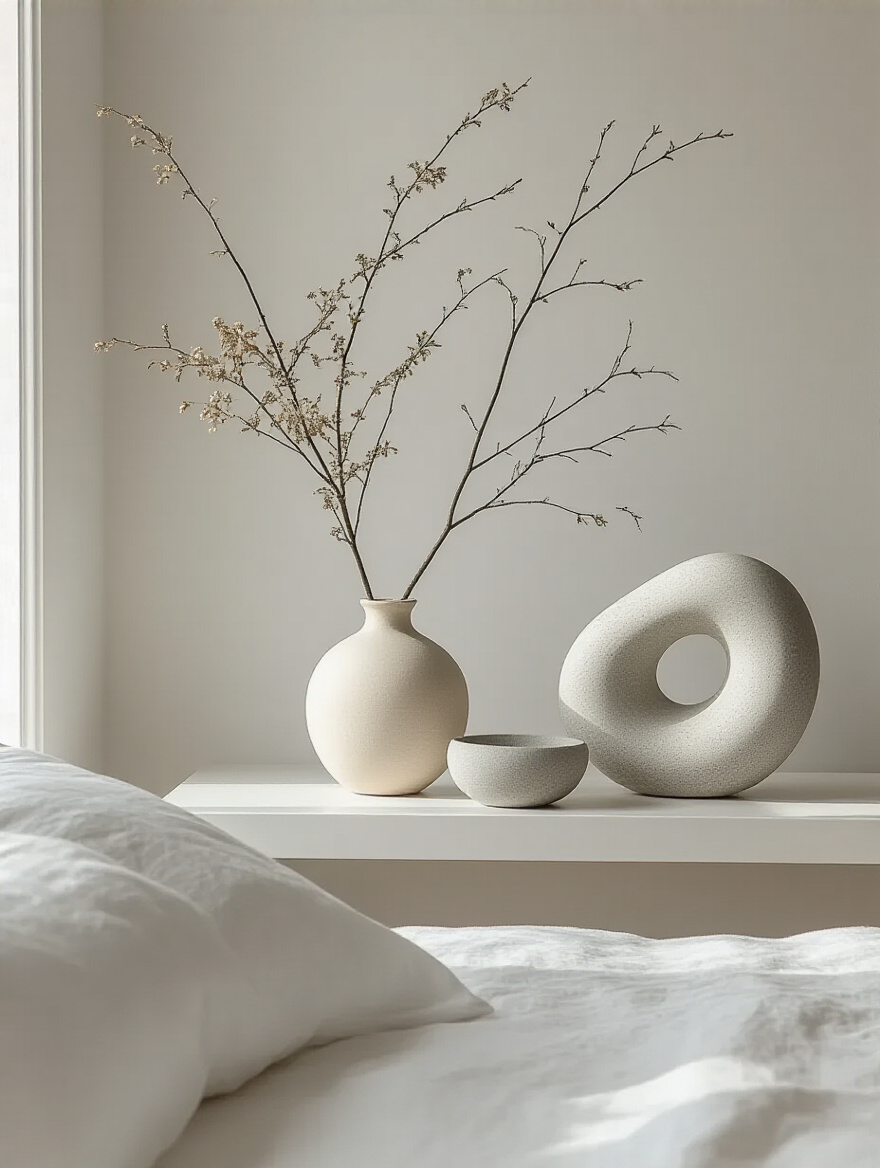
The key is restraint. You don’t need a lot. One beautiful vase (even without flowers), a stack of two or three art books, and a small ceramic dish for your rings is a perfect composition. Follow the “Rule of Three”—grouping items in odd numbers is almost always more visually pleasing. And play with height: something tall, something medium, and something low. This creates a balanced, curated feel that looks intentional, not cluttered.
These small, sculptural details add a quiet artistry to the room, which can be beautifully complemented by adding a touch of life itself.
14. Introduce Greenery and Live Plants for Organic Contrast
Every single room, without exception, needs something living in it. In a white bedroom, a plant is like a breath of fresh air for your eyes. The vibrant, organic green provides the perfect pop of color without feeling jarring. It breaks up all the white and adds a natural, sculptural element that feels both calming and energizing.
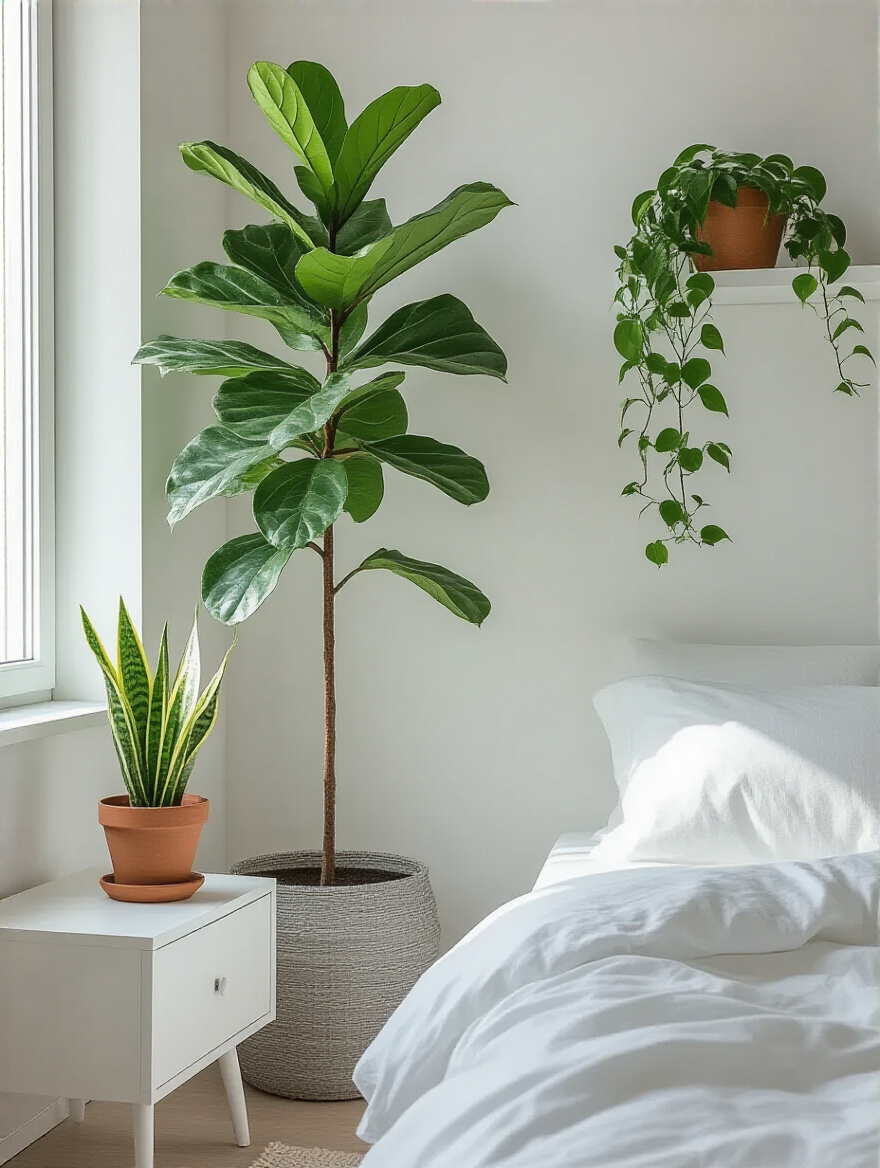
You don’t need to turn your room into a jungle. One well-placed plant can be enough. A tall Fiddle Leaf Fig in a corner can add dramatic height, while a trailing Pothos on a high shelf can add a soft, cascading effect. If you’re convinced you have a black thumb, start with a Snake Plant or a ZZ Plant. They are nearly indestructible and thrive on neglect. Don’t forget the pot! The planter is another opportunity to add texture, whether it’s a rustic terracotta pot, a sleek ceramic one, or a warm woven basket.
Adding greenery provides a soft, natural contrast, but for a more graphic and defined look, a little bit of black goes a long way.
15. Curate Black or Metallic Accents to Define the Space
An all-white room can sometimes lack definition. The easiest way to add a bit of punctuation and make everything else “pop” is to add a few touches of black or a metallic finish. Think of black as the eyeliner of interior design—it defines and sharpens everything around it. A thin black metal bed frame, black picture frames, or a black-and-white piece of art can look incredibly chic and sophisticated.
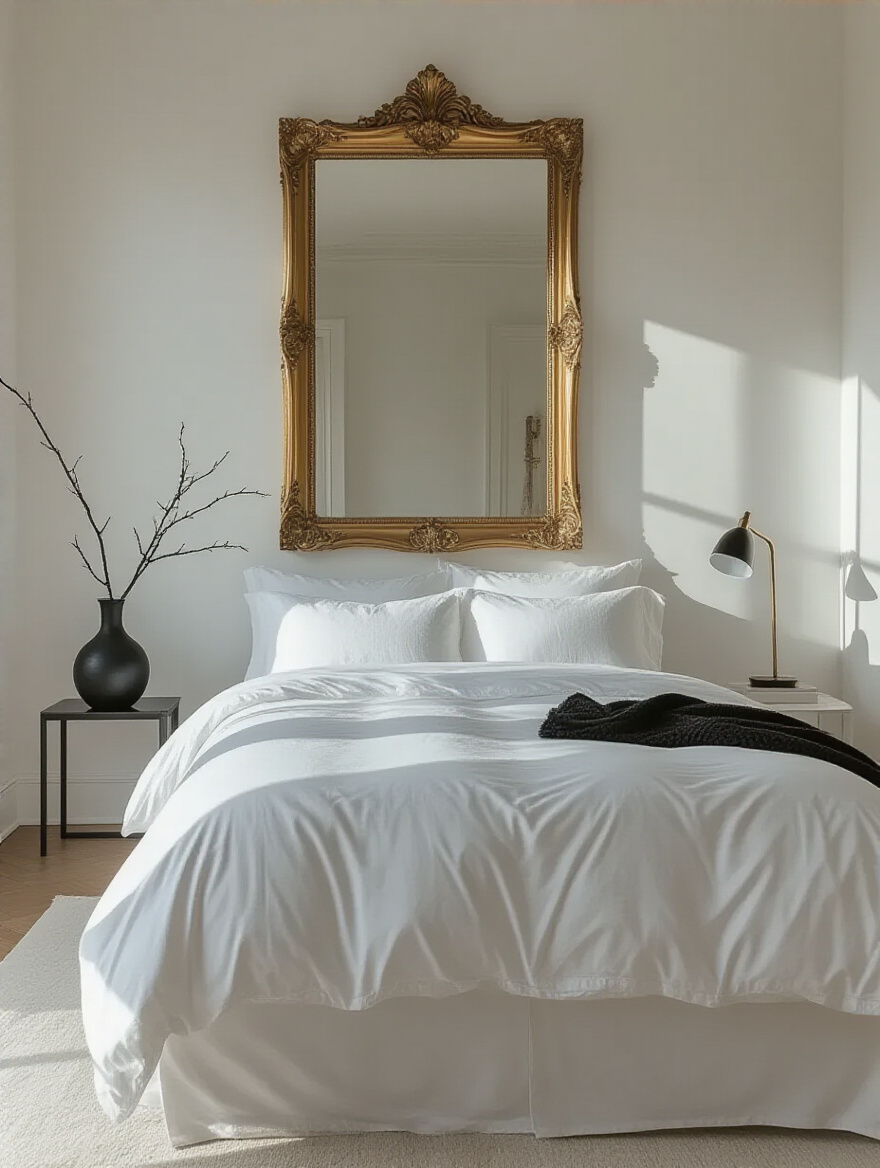
If black feels too harsh for your mood, metallics work just as well. A touch of warm brass or champagne bronze adds warmth and a little bit of glamour. This could be in your lamp bases, curtain rod, drawer pulls, or a beautifully framed mirror. The key is to be consistent and sparing. Choose one metal finish and sprinkle it in two or three places around the room. It’s that little bit of contrast that makes the white look even whiter and the entire design feel more intentional.
These defining accents provide a frame, drawing the eye toward the most personal elements in the room: the art.
16. Select Thoughtful Wall Art to Personalize Your White Canvas
Your white walls are a gallery just waiting for you. Wall art is the most personal element of your room, and it’s your chance to tell a story. Don’t just buy something because it “matches.” Choose art that you truly love, that makes you feel something. A white backdrop is incredibly forgiving and will make almost any piece of art shine. A large, abstract piece over the bed can serve as a stunning focal point, setting the color palette for your small accents.
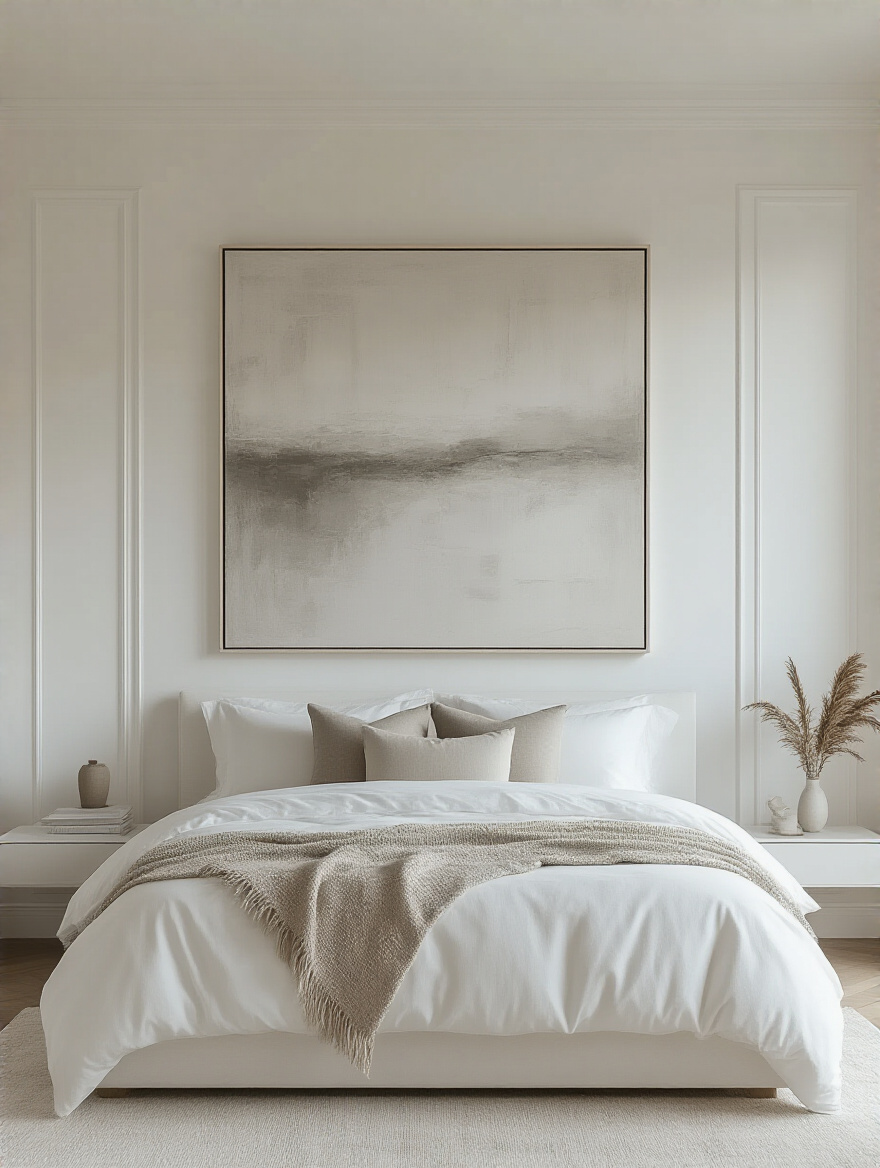
Alternatively, a gallery wall of smaller personal photos, prints, and objects can add a wonderful, collected-over-time feel. A tip for making a gallery wall look cohesive is to stick to a consistent frame style or color. All-black frames or all-natural wood frames will tie a collection of disparate images together beautifully. And remember, art doesn’t have to be a painting. A beautiful textile, a macrame wall hanging, or even a collection of flat woven baskets can serve as art while adding incredible texture.
Elevating the Serene Space: Styling, Accents, and Personal Touches (Part 2)
We are in the home stretch now, focusing on the subtle, often invisible, details that have a huge impact on how a room feels. This is about engaging more than just your eyes. We’re creating a multi-sensory experience that cements your bedroom as a true sanctuary, a place of ultimate comfort and peace.
17. Enhance the Sensory Experience with Subtle Scents and Aromas
A beautiful room that doesn’t smell good isn’t truly beautiful. Scent is a powerful tool for setting a mood and is a crucial, often forgotten, layer of design. You want to create a subtle, signature scent for your bedroom that signals to your brain that it’s time to relax and unwind. This isn’t about overpowering plug-ins or cloying potpourri. We’re talking about elegant subtlety.

An essential oil diffuser is a wonderful option. A few drops of lavender, chamomile, or cedarwood oil can create a calming atmosphere. A high-quality soy or coconut wax candle with a sophisticated scent can also work beautifully. My favorite trick is a simple linen spray. A light misting over your pillows and curtains before bed can make slipping into bed feel like an indulgence. The key is to find one scent you love and use it consistently, so that aroma becomes synonymous with peace and rest.
With the sense of smell engaged, let’s double down on the sense of touch by perfecting our cozy layers.
18. Maximize Coziness with Soft Throws and Decorative Pillows
We touched on this when building the bed, but it’s so important it deserves its own moment. Throws and pillows are the jewelry of the room. They are the final styling pieces that pull everything together and scream “comfort.” A beautiful throw is non-negotiable. It could be a super-soft cashmere blend, a chunky knit wool, or even a lightweight linen for warmer climates. Don’t just fold it perfectly at the foot of the bed. Casually drape it over a corner of the bed or toss it over an accent chair to look effortlessly chic.
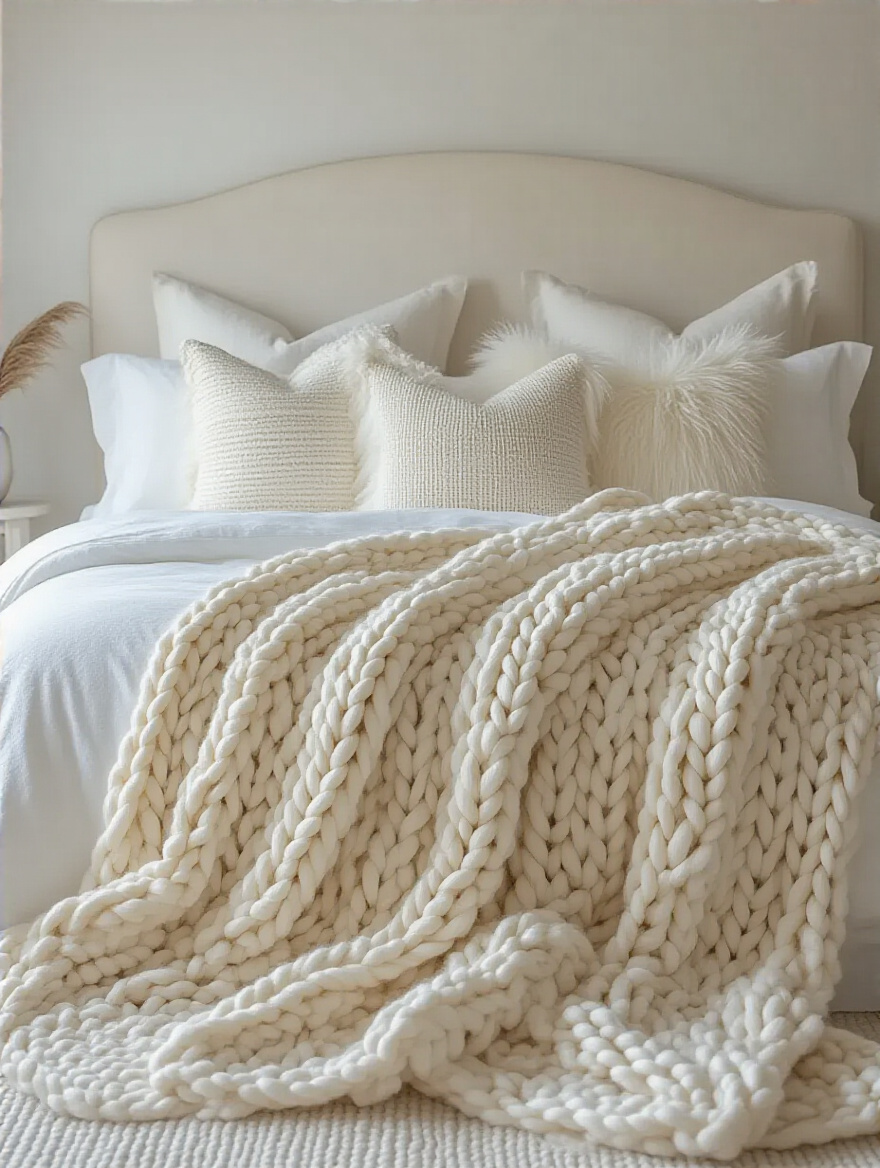
For pillows, this is where you can have a little fun. While your bed is primarily white, one or two of your decorative pillows could have a subtle pattern, a different texture like velvet or bouclé, or a slightly different shade like a soft cream or pale grey. This adds a final layer of visual interest and makes the bed look complete. Remember, these are the items your hands and body will actually interact with, so prioritize materials that feel absolutely divine to the touch.
This feeling of tactile luxury should extend even to the things that aren’t on display.
19. Keep Surfaces Minimal and Styled with Purposeful Items
Now that you have all these beautiful things, the final rule of a serene white bedroom is to practice restraint. Your surfaces—your nightstand, your dresser—should remain 90% clear. A cluttered surface equals a cluttered mind. This goes back to our discreet storage solutions; everything should have a home so it’s not living on your dresser. This allows the few beautiful objects you’ve chosen to shine.
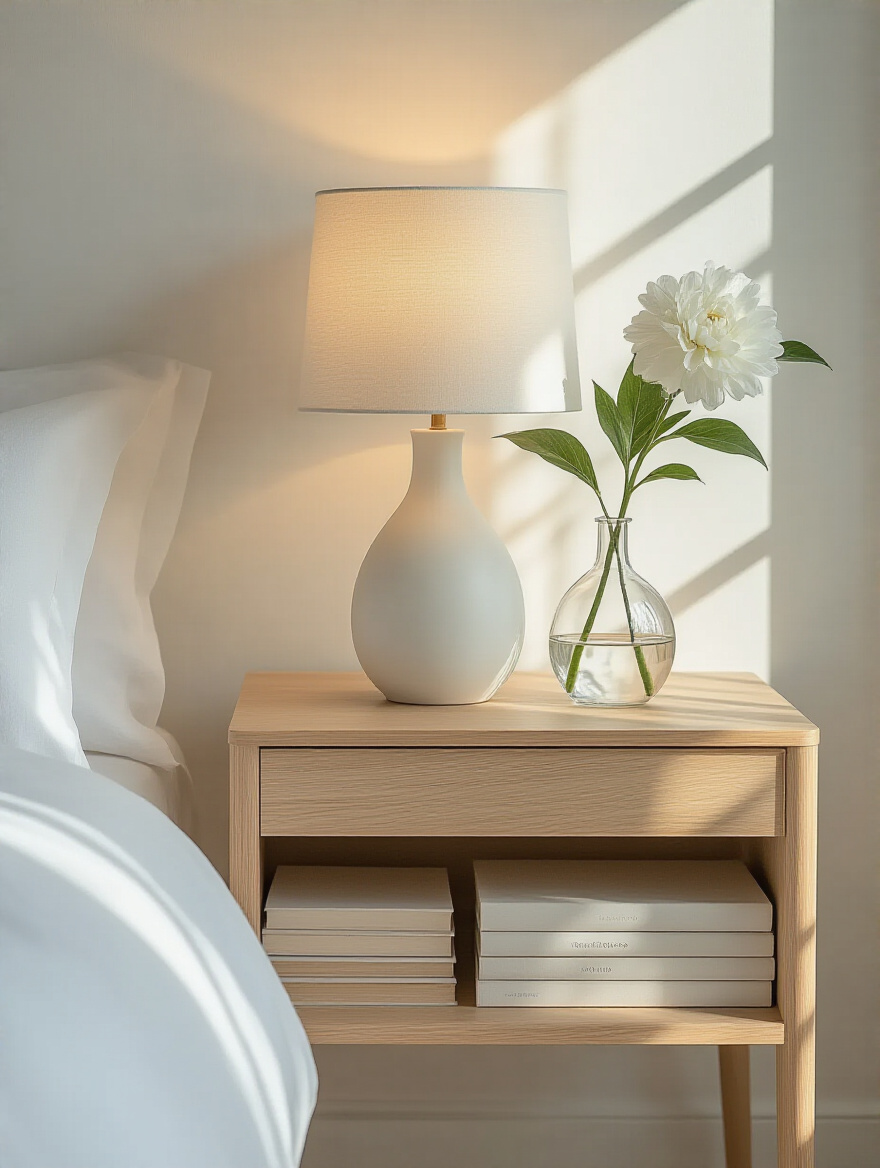
Your nightstand should hold only the essentials: a lamp, maybe a small plant or a single framed photo, and the book you’re currently reading. Anything else—hand cream, chargers, half-empty glasses of water—needs to be cleared away each morning. It’s a simple habit that takes less than 30 seconds but has a massive impact on the calm feeling of your room. Think of it as a daily gift to your future self. Curation isn’t just about what you display; it’s about what you choose to put away.
Conclusion
So there you have it. The secret to a stunning white bedroom isn’t a magic paint color; it’s a thoughtful symphony of texture, light, warmth, and personal touches. We’ve moved from the fear of a sterile, cold box to the promise of a warm, inviting, and deeply personal sanctuary. By focusing on layers—from soft linen and chunky knits to warm woods and reflective metals—you give a white room its soul. It’s about creating a space that doesn’t just look good on camera, but feels incredible to live in.
Imagine waking up in a room that feels like a soft, bright cocoon, a space that calms your mind and prepares you for the day. That is the true power of a well-designed white bedroom. It’s not about restriction; it’s about providing a quiet, beautiful backdrop for your life. So start small. Pick one thing—maybe it’s a new set of linen sheets or a beautiful chunky throw—and see how it transforms the space. Your dream retreat isn’t a far-off fantasy; it’s just a few thoughtful layers away. Go create the sanctuary you deserve.
